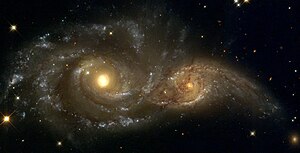NGC 2207
| Galaxy NGC 2207 |
|
|---|---|

|
|
| The galaxies NGC 2207 (left) and IC 2163 (right) captured by the Hubble Space Telescope | |
| AladinLite | |
| Constellation | Big dog |
|
Position equinox : J2000.0 , epoch : J2000.0 |
|
| Right ascension | 06 h 16 m 22.0 s |
| declination | -21 ° 22 ′ 22 ″ |
| Appearance | |
| Morphological type | SAB (rs) bc pec |
| Brightness (visual) | 11.0 mag |
| Brightness (B-band) | 11.8 mag |
| Angular expansion | 3.9 ′ × 2.2 ′ |
| Position angle | 141 ° |
| Surface brightness | 13.2 mag / arcmin² |
| Physical data | |
| Redshift | (+9143 ± 50) · 10 −6 |
| Radial velocity | 2741 ± 15 km / s |
|
Stroke distance v rad / H 0 |
(115 ± 8) x 10 6 ly (35.2 ± 2.5) Mpc |
| history | |
| discovery | John Herschel |
| Discovery date | January 24, 1835 |
| Catalog names | |
| NGC 2207 • UGCA 124 • PGC 18749 • ESO 556-G08 • MCG -04-15-20 • IRAS 06142-2121 • 2MASX J06162209-2122217 • GC 1393 • h 3032 • LDCE 0431 NED008 | |
NGC 2207 is a bar-spiral galaxy of the Hubble-type SBbc / P in the constellation of the Big Dog, about 115 million light-years from the Milky Way . NGC 2207 captures the nearby galaxy IC 2163 with its gravity . In about a billion years, these two interacting galaxies will merge into a single larger one. So far, two supernovae have been observed in NGC 2207 - SN 1999ec and SN 2003H .
The galaxy NGC 2207 was discovered on January 24, 1835 by the British astronomer John Herschel .
Web links
- Spitzer Space Telescope ( Memento from July 24, 2008 in the Internet Archive )
- Presentation of colliding galaxies (PDF file; 1.4 MB)
- Lecture by the DFG ( Memento from September 29, 2007 in the Internet Archive ) (PDF file; 1.4 MB)
- ESO: An all-seeing eye
- astronews.com: Picture of the day November 11, 2016
